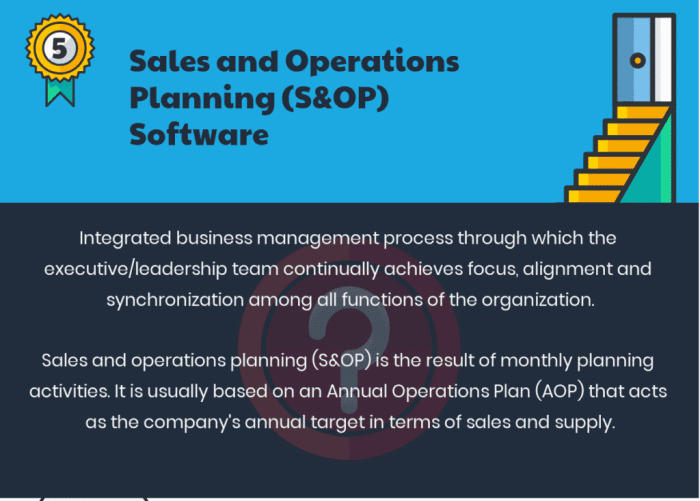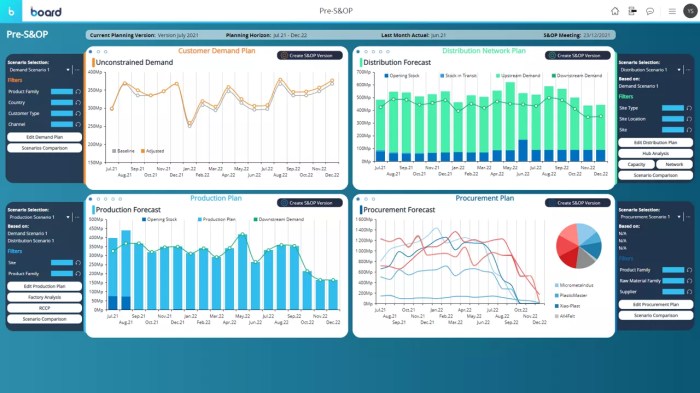Sales & operations planning software – Sales & Operations Planning (S&OP) software revolutionizes how businesses manage their resources and meet market demands. By integrating sales forecasts, production capacity, and inventory levels, S&OP software empowers companies to make data-driven decisions, optimizing their supply chains for greater efficiency and profitability. This sophisticated approach fosters better collaboration across departments, leading to improved customer satisfaction and reduced operational costs.
The software’s ability to predict future trends allows businesses to proactively adjust their strategies, minimizing risks and maximizing opportunities in a dynamic market environment.
Effective S&OP requires a robust system capable of handling complex data sets and providing clear, actionable insights. Many solutions offer advanced features such as demand planning, supply chain simulation, and performance reporting dashboards. Choosing the right software depends on the specific needs of the business, considering factors like industry, size, and complexity of operations. Implementation also requires careful planning and user training to ensure successful adoption and maximize return on investment.
In today’s dynamic business environment, effective planning is paramount for success. Sales & Operations Planning (S&OP) software emerges as a crucial tool for organizations striving for optimal alignment between sales forecasts and operational capabilities. This comprehensive guide delves into the intricacies of S&OP software, exploring its features, benefits, implementation, and future trends. We’ll also address frequently asked questions to provide a complete understanding of this vital business tool.
Understanding Sales & Operations Planning (S&OP)
S&OP, also known as Integrated Business Planning (IBP), is a strategic process that brings together various departments – sales, marketing, operations, finance, and supply chain – to create a unified business plan. This collaborative approach ensures that everyone is working towards the same goals, minimizing conflicts and maximizing efficiency. The core objective is to balance supply and demand, optimizing inventory levels, production schedules, and resource allocation to meet customer expectations while maximizing profitability.
Key Components of S&OP
- Demand Planning: Forecasting future customer demand based on historical data, market trends, and promotional activities. This often involves sophisticated statistical modeling and machine learning techniques.
- Supply Planning: Determining the capacity and resources needed to meet the forecasted demand. This includes production planning, inventory management, and supplier collaboration.
- Sales & Operations Execution: Implementing the agreed-upon plan, monitoring performance, and making adjustments as needed. This involves real-time data monitoring and exception management.
- Financial Planning & Analysis: Integrating financial considerations into the planning process to ensure that the plan aligns with the company’s overall financial goals.
The Role of S&OP Software
While S&OP can be implemented manually using spreadsheets and other basic tools, dedicated S&OP software significantly enhances the process. These software solutions provide advanced functionalities that streamline the planning process, improve accuracy, and facilitate collaboration. They offer a centralized platform for data management, analysis, and communication.
Key Features of S&OP Software, Sales & operations planning software
- Demand Forecasting: Advanced forecasting algorithms, including exponential smoothing, ARIMA, and machine learning, to predict future demand with greater accuracy.
- Supply Chain Modeling: Simulation tools to model different scenarios and assess the impact of various decisions on the supply chain.
- Inventory Optimization: Algorithms to optimize inventory levels, minimizing holding costs while ensuring sufficient stock to meet demand.
- Production Scheduling: Tools to create and manage production schedules, optimizing resource utilization and minimizing lead times.
- Collaboration & Communication: Centralized platform for sharing data and collaborating with different departments.
- Reporting & Analytics: Dashboards and reports to track key performance indicators (KPIs) and monitor the effectiveness of the S&OP process. This includes features for what-if analysis and scenario planning.
- Integration with ERP Systems: Seamless integration with existing Enterprise Resource Planning (ERP) systems to ensure data consistency and accuracy.
Benefits of Implementing S&OP Software
Implementing S&OP software offers numerous benefits, leading to improved business performance and increased profitability. These benefits include:
- Improved Forecast Accuracy: More accurate demand forecasts lead to better inventory management and reduced stockouts.
- Reduced Inventory Costs: Optimized inventory levels minimize holding costs and reduce the risk of obsolescence.
- Increased Production Efficiency: Improved production scheduling leads to better resource utilization and reduced lead times.
- Enhanced Customer Service: Meeting customer demand more consistently improves customer satisfaction and loyalty.
- Better Collaboration: A centralized platform facilitates better communication and collaboration between departments.
- Improved Profitability: By optimizing all aspects of the supply chain, S&OP software contributes significantly to increased profitability.
- Reduced Risk: Proactive identification and mitigation of potential supply chain disruptions.
Choosing the Right S&OP Software
Selecting the right S&OP software is crucial for maximizing its benefits. Consider the following factors:

Source: liveabout.com
- Scalability: Ensure the software can adapt to your company’s growth.
- Integration Capabilities: Check for seamless integration with your existing ERP and other systems.
- User-Friendliness: Choose software that is easy to use and understand for all stakeholders.
- Reporting & Analytics: Ensure the software provides comprehensive reporting and analytics capabilities.
- Vendor Support: Select a vendor with a strong track record and excellent customer support.
- Cost: Consider the total cost of ownership, including software licensing, implementation, and training.
Implementation of S&OP Software
Implementing S&OP software requires careful planning and execution. A phased approach is often recommended, starting with a pilot project before rolling out the software to the entire organization. Key steps include:
- Needs Assessment: Identify your company’s specific needs and requirements.
- Software Selection: Choose the software that best meets your needs.
- Data Migration: Transfer existing data to the new software.
- User Training: Provide comprehensive training to all users.
- Go-Live: Launch the software and monitor its performance.
- Continuous Improvement: Regularly review and improve the S&OP process.
Future Trends in S&OP Software
The S&OP software landscape is constantly evolving, with several key trends emerging:
- Increased Use of AI and Machine Learning: AI and machine learning are being used to improve forecast accuracy and automate various aspects of the S&OP process.
- Cloud-Based Solutions: Cloud-based S&OP software is becoming increasingly popular due to its scalability and cost-effectiveness.
- Enhanced Collaboration Tools: Software vendors are constantly improving collaboration tools to facilitate better communication and data sharing.
- Integration with IoT Devices: Integration with Internet of Things (IoT) devices provides real-time visibility into the supply chain.
Frequently Asked Questions (FAQ): Sales & Operations Planning Software
- Q: What is the difference between S&OP and IBP? A: While often used interchangeably, IBP (Integrated Business Planning) is a broader term that encompasses S&OP and extends to other areas of the business, such as finance and strategy.
- Q: How much does S&OP software cost? A: The cost varies widely depending on the vendor, features, and implementation needs. Expect a range from several thousand dollars to hundreds of thousands of dollars annually.
- Q: How long does it take to implement S&OP software? A: Implementation time varies depending on the complexity of the project and the size of the organization. It can range from a few months to over a year.
- Q: What are the key metrics for measuring the success of S&OP? A: Key metrics include forecast accuracy, inventory turnover, customer service levels, and on-time delivery.
- Q: Can S&OP software be used by small businesses? A: Yes, many S&OP software solutions are available that cater to the needs of small and medium-sized businesses (SMBs).
Conclusion
Sales & Operations Planning software is a powerful tool that can significantly improve business performance by aligning sales forecasts with operational capabilities. By carefully considering the factors discussed in this guide, organizations can select and implement S&OP software to optimize their supply chain, enhance customer service, and increase profitability. The future of S&OP software is bright, with continued advancements in AI, cloud computing, and IoT promising even greater benefits in the years to come.
Call to Action
Ready to transform your business planning? Contact us today for a free consultation and discover how S&OP software can help you achieve your business goals. Let’s optimize your supply chain together!
Ultimately, the implementation of sales & operations planning software represents a significant step towards achieving greater operational excellence. By fostering better collaboration, improving forecasting accuracy, and providing valuable insights into supply chain dynamics, S&OP software empowers businesses to become more agile, responsive, and profitable. The benefits extend beyond immediate cost savings, contributing to long-term growth and sustainable competitive advantage in today’s ever-evolving marketplace.
Investing in the right S&OP solution is an investment in the future success of the organization.
Commonly Asked Questions
What are the key benefits of using S&OP software?
Improved forecasting accuracy, better inventory management, reduced operational costs, enhanced collaboration, increased customer satisfaction, and improved profitability.
How much does S&OP software typically cost?

Source: predictiveanalyticstoday.com
Pricing varies greatly depending on the vendor, features, and number of users. Expect a range from several thousand dollars annually to significantly more for enterprise-level solutions. Many vendors offer tiered pricing plans.

Source: board.com
What are some common challenges in implementing S&OP software?
Data integration issues, resistance to change from employees, lack of user training, and insufficient executive sponsorship can hinder successful implementation.
How long does it typically take to implement S&OP software?
Implementation timelines vary depending on the complexity of the system and the size of the organization. Projects can range from a few months to over a year.
What types of industries benefit most from S&OP software?
While beneficial across various sectors, industries with complex supply chains and high demand variability, such as manufacturing, retail, and food processing, often see the greatest returns.